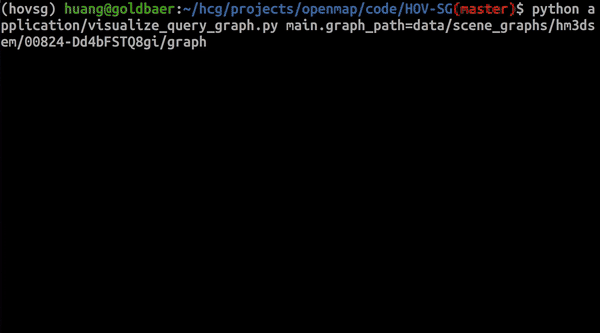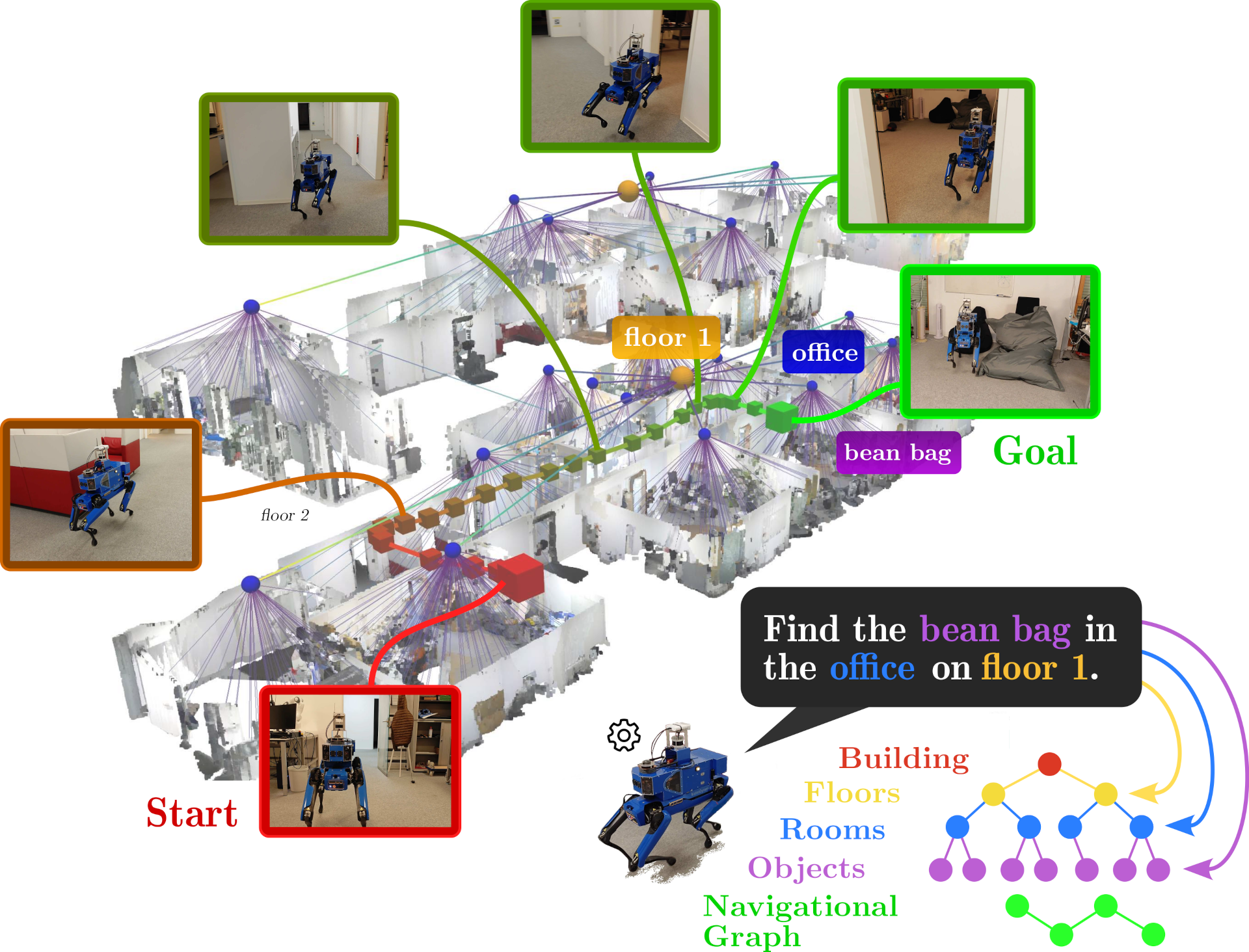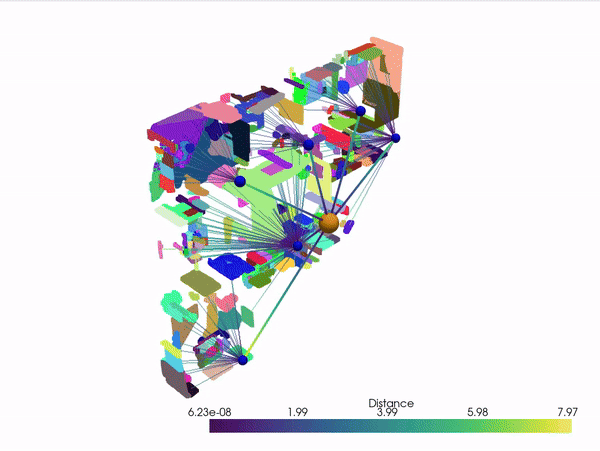This repository is the official implementation of the paper:
Hierarchical Open-Vocabulary 3D Scene Graphs for Language-Grounded Robot Navigation
Abdelrhman Werby*, Chenguang Huang*, Martin Büchner*, Abhinav Valada, and Wolfram Burgard.
*Equal contribution.arXiv preprint arXiv:2403.17846, 2024
(Accepted for Robotics: Science and Systems (RSS), Delft, Netherlands, 2024.)
- [29 Aug 2024] We added
hm3dsem_walksdataset generation and hierarchical scene graph evaluation code.
Please review the updated code structure and newly added dependencies for dataset construction. - [01 Jul 2024] Initial release of HOV-SG including mapping and graph construction engine.
- Clone and set up the HOV-SG repository
git clone https://github.com/hovsg/HOV-SG.git
cd HOV-SG
# set up virtual environment and install habitat-sim afterwards separately to avoid errors.
conda env create -f environment.yaml
conda activate hovsg
conda install habitat-sim -c conda-forge -c aihabitat
# set up the HOV-SG python package
pip install -e .HOV-SG uses the Open CLIP model to extract features from RGB-D frames. To download the Open CLIP model checkpoint CLIP-ViT-H-14-laion2B-s32B-b79K please refer to Open CLIP.
mkdir checkpoints
wget https://huggingface.co/laion/CLIP-ViT-H-14-laion2B-s32B-b79K/resolve/main/open_clip_pytorch_model.bin?download=true -O checkpoints/temp_open_clip_pytorch_model.bin && mv checkpoints/temp_open_clip_pytorch_model.bin checkpoints/laion2b_s32b_b79k.binAnother option is to use the OVSeg fine-tuned Open CLIP model, which is available under here:
pip install gdown
gdown --fuzzy https://drive.google.com/file/d/17C9ACGcN7Rk4UT4pYD_7hn3ytTa3pFb5/view -O checkpoints/ovseg_clip.pthHOV-SG uses SAM to generate class-agnostic masks for the RGB-D frames. To download the SAM model checkpoint sam_v2 execute the following:
wget https://dl.fbaipublicfiles.com/segment_anything/sam_vit_h_4b8939.pth -O checkpoints/sam_vit_h_4b8939.pthHOV-SG takes posed RGB-D sequences as input. In order to produce hierarchical multi-story scenes we make use of the Habitat 3D Semantics dataset (HM3DSem).
-
Download the Habitat Matterport 3D Semantics dataset.
Make sure that the raw HM3D dataset has the following structure:
├── hm3d │ ├── hm3d_annotated_basis.scene_dataset_config.json # this file is necessary │ ├── val │ │ └── 00824-Dd4bFSTQ8gi │ │ ├── Dd4bFSTQ8gi.basis.glb │ │ ├── Dd4bFSTQ8gi.basis.navmesh │ │ ├── Dd4bFSTQ8gi.glb │ │ ├── Dd4bFSTQ8gi.semantic.glb │ │ └── Dd4bFSTQ8gi.semantic.txt ... ... ...
We used the following scenes from the Habitat Matterport 3D Semantics dataset in our evaluation:
Show Scenes ID
00824-Dd4bFSTQ8gi00829-QaLdnwvtxbs00843-DYehNKdT76V00861-GLAQ4DNUx5U00862-LT9Jq6dN3Ea00873-bxsVRursffK00877-4ok3usBNeis00890-6s7QHgap2fW
- Our method requires posed input data. Because of that, we recorded trajectories for each sequence we evaluate on. We provide a script (
hovsg/data/hm3dsem/gen_hm3dsem_walks_from_poses.py) that turns a set of camera poses (hovsg/data/hm3dsem/metadata/poses) into a sequence of RGB-D observations using the habitat-sim simulator. The output includes RGB, depth, poses and frame-wise semantic/panoptic ground truth:
python data/habitat/gen_hm3dsem_from_poses.py --dataset_dir <hm3dsem_dir> --save_dir data/hm3dsem_walks/- Secondly, we construct a new hierarchical graph-structured dataset that is called
hm3dsem_walksthat includes ground truth based on all observations recorded. To produce this ground-truth data please execute the following: First, define the following config paths:main.package_path,main.dataset_path,main.raw_data_path, andmain.save_pathunderconfig/create_graph.yaml. For each scene, define themain.scene_id,main.split. Next, execute the following to obtain floor-, region-, and object-level ground truth data per scene. We utilize every recorded frame without skipping (see parameterdataset.hm3dsem.gt_skip_frames) and recommend 128 GB of RAM to compile this as the scenes differ in size:
cd HOV-SG
python hovsg/data/hm3dsem/create_hm3dsem_walks_gt.pyTo evaluate semantic segmentation cababilities, we used ScanNet and Replica.
To get an RGBD sequence for ScanNet, download the ScanNet dataset from the official website. The dataset contains RGB-D frames compressed as .sens files. To extract the frames, use the SensReader/python. We used the following scenes from the ScanNet dataset:
Show Scenes ID
scene0011_00scene0050_00scene0231_00scene0378_00scene0518_00
To get an RGBD sequence for Replica, Instead of the original Replica dataset, download the scanned RGB-D trajectories of the Replica dataset provided by Nice-SLAM. It contains rendered trajectories using the mesh models provided by the original Replica datasets. Download the Replica RGB-D scan dataset using the downloading script in Nice-SLAM.
wget https://cvg-data.inf.ethz.ch/nice-slam/data/Replica.zip -O data/Replica.zip && unzip data/Replica.zip -d data/Replica_RGBD && rm data/Replica.zip To evaluate against the ground truth semantics labels, you also need also to download the original Replica dataset from the Replica as it contains the ground truth semantics labels as .ply files.
git clone https://github.com/facebookresearch/Replica-Dataset.git data/Replica-Dataset
chmod +x data/Replica-Dataset/download.sh && data/Replica-Dataset/download.sh data/Replica_originalWe only used the following scenes from the Replica dataset:
Show Scenes ID
office0office1office2office3office4room0room1room2
The Data folder should have the following structure:
Show data folder structure
├── hm3dsem_walks
│ ├── val
│ │ ├── 00824-Dd4bFSTQ8gi
│ │ │ ├── depth
│ │ │ │ ├── Dd4bFSTQ8gi-000000.png
│ │ │ │ ├── ...
│ │ │ ├── rgb
│ │ │ │ ├── Dd4bFSTQ8gi-000000.png
│ │ │ │ ├── ...
│ │ │ ├── semantic
│ │ │ │ ├── Dd4bFSTQ8gi-000000.png
│ │ │ │ ├── ...
│ │ │ ├── pose
│ │ │ │ ├── Dd4bFSTQ8gi-000000.png
│ │ │ │ ├── ...
| | ├── 00829-QaLdnwvtxbs
| | ├── ..
├── Replica
│ ├── office0
│ │ ├── results
│ │ │ ├── depth0000.png
│ │ │ ├── ...
│ │ | ├── rgb0000.png
│ │ | ├── ...
│ │ ├── traj.txt
│ ├── office1
│ ├── ...
├── ScanNet
│ ├── scans
│ │ ├── scene0011_00
│ │ │ ├── color
│ │ │ │ ├── 0.jpg
│ │ │ │ ├── ...
│ │ │ ├── depth
│ │ │ │ ├── 0.png
│ │ │ │ ├── ...
│ │ │ ├── poses
│ │ │ │ ├── 0.txt
│ │ │ │ ├── ...
│ │ │ ├── internsics
│ │ │ │ ├── intrinsics_color.txt
│ │ │ │ ├── intrinsics_depth.txt
│ │ ├── ..
python application/create_graph.py main.dataset=hm3dsem main.dataset_path=data/hm3dsem_walks/val/00824-Dd4bFSTQ8gi/ main.save_path=data/scene_graphs/00824-Dd4bFSTQ8giThis will generate a scene graph for the specified RGB-D sequence and save it. The following files are generated:
├── graph
│ ├── floors
│ │ ├── 0.json
│ │ ├── 0.ply
│ │ ├── 1.json
│ │ ├── ...
│ ├── rooms
│ │ ├── 0_0.json
│ │ ├── 0_0.ply
│ │ ├── 0_1.json
│ │ ├── ...
│ ├── objects
│ │ ├── 0_0_0.json
│ │ ├── 0_0_0.ply
│ │ ├── 0_0_1.json
│ │ ├── ...
│ ├── nav_graph
├── tmp
├── full_feats.pt
├── mask_feats.pt
├── full_pcd.ply
├── masked_pcd.ply
The graph folder contains the generated scene graph hierarchy, the first number in the file name represents the floor number, the second number represents the room number, and the third number represents the object number. The tmp folder holds intermediate results obtained throughout graph construction. The full_feats.pt and mask_feats.pt contain the features extracted from the RGBD frames using the Open CLIP and SAM models. the former contains per point features and the latter contains the features for the object masks. The full_pcd.ply and masked_pcd.ply contain the point cloud representation of the RGB-D frames and the instance masks of all objects, respectively.
python application/visualize_graph.py graph_path=data/scene_graphs/hm3dsem/00824-Dd4bFSTQ8gi/graphIn order to test graph queries with HOV-SG, you need to setup an OpenAI API account with the following steps:
- Sign up an OpenAI account, login your account, and bind your account with at least one payment method.
- Get you OpenAI API keys, copy it.
- Open your
~/.bashrcfile, paste a new lineexport OPENAI_KEY=<your copied key>, save the file, and source it with commandsource ~/.bashrc. Another way would be to runexport OPENAI_KEY=<your copied key>in the teminal where you want to run the query code.
python application/visualize_query_graph.py main.graph_path=data/scene_graphs/hm3dsem/00824-Dd4bFSTQ8gi/graphAfter launching the code, you will be asked to input the hierarchical query. An example is chair in the living room on floor 0. You can see the visualization of the top 5 target objects and the room it lies in.

python application/semantic_segmentation.py main.dataset=replica main.dataset_path=Replica/office0 main.save_path=data/sem_seg/office0python application/eval/evaluate_sem_seg.py dataset=replica scene_name=office0 feature_map_path=data/sem_seg/office0- Define the scene identifiers and paths of ground truth and the predicted scene graph in the
config/eval_graph.yaml. - Run the graph evaluation method:
python application/eval/evaluate_graph.py Recent open-vocabulary robot mapping methods enrich dense geometric maps with pre-trained visual-language features. While these maps allow for the prediction of point-wise saliency maps when queried for a certain language concept, largescale environments and abstract queries beyond the object level still pose a considerable hurdle, ultimately limiting languagegrounded robotic navigation. In this work, we present HOVSG, a hierarchical open-vocabulary 3D scene graph mapping approach for language-grounded indoor robot navigation. Leveraging open-vocabulary vision foundation models, we first obtain state-of-the-art open-vocabulary segment-level maps in 3D and subsequently construct a 3D scene graph hierarchy consisting of floor, room, and object concepts, each enriched with openvocabulary features. Our approach is able to represent multistory buildings and allows robotic traversal of those using a cross-floor Voronoi graph. HOV-SG is evaluated on three distinct datasets and surpasses previous baselines in open-vocabulary semantic accuracy on the object, room, and floor level while producing a 75% reduction in representation size compared to dense open-vocabulary maps. In order to prove the efficacy and generalization capabilities of HOV-SG, we showcase successful long-horizon language-conditioned robot navigation within realworld multi-story environments.
If you find our work useful, please consider citing our paper:
@article{werby23hovsg,
Author = {Abdelrhman Werby and Chenguang Huang and Martin Büchner and Abhinav Valada and Wolfram Burgard},
Title = {Hierarchical Open-Vocabulary 3D Scene Graphs for Language-Grounded Robot Navigation},
Year = {2024},
journal = {Robotics: Science and Systems},
}
For academic usage, the code is released under the MIT license. For any commercial purpose, please contact the authors.
This work was funded by the German Research Foundation (DFG) Emmy Noether Program grant number 468878300, the BrainLinks-BrainTools Center of the University of Freiburg, and an academic grant from NVIDIA.





